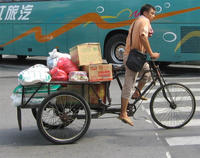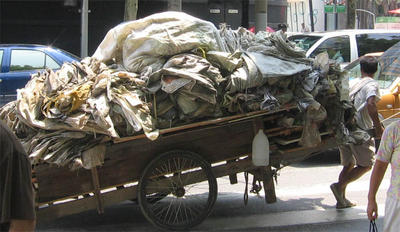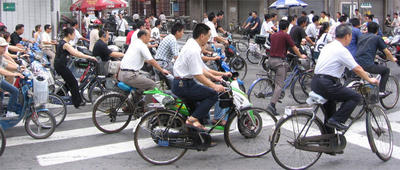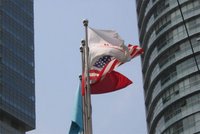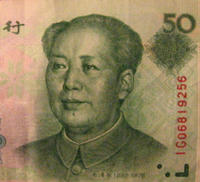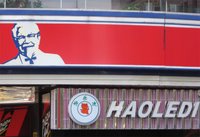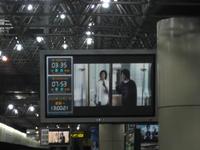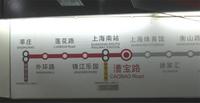 Part of the motivation was to retrace the setting of Suzhou River, a small & quirky art film I consider to be the best movie ever made in the PRC proper. The movie depicts the river as a vast armpit to the city, wildly polluted and populated by gangsters and squatters - but which still holds an attraction to the videoographer narrator.
Part of the motivation was to retrace the setting of Suzhou River, a small & quirky art film I consider to be the best movie ever made in the PRC proper. The movie depicts the river as a vast armpit to the city, wildly polluted and populated by gangsters and squatters - but which still holds an attraction to the videoographer narrator.I knew the scenery would be different from the movie, because the movie is all of five or six years old, which is equal to about ten times that in US city years. Also, I talked to a local girl the day before the hike, she's into the art movies - she says right after the movie came out, there was a huge cleanup of the area.
I took the metro out to ZhongShan Park on an overcast day that wasn't quite the best for photography, but kept me from dying of sunstroke. Between the park and the river is a colorful area combining the back-alley charm of Shanghai with big apartment buildings, with a lot of local restaurants to boot. I was thinking it would be a pleasant place to live when I stumbled across the river. This look at the Suzhou River was a surprise: rather than the neighberhood being built around the river, the river was nearly boxed in by concrete barriers I could barely see over despite my height, and surrounded by warehouses and the like.

Although of course it makes sense if you consider that until recently, the river was basically a sewer. I walked down the dirt road, and it wasn't too long until I could see a row of new apartment buildings across the river. There was a break in the river-barriers, and a small park front where you could look over the river. Also note the laundry hanging in nearly every lanai.

However the barriers went right back up, and there was a long stretch of sparcely peopled road, with small warehouses and the occasional recycling center. And "sparcely peopled" isn't something you often get to say about Shanghai.


I also ran across the occasional alleyway of houses. I'm not sure if these houses were occupied by squatters or if it's a step above that. Either way, the houses seem stuck together with whatever happened to be handy at the time. I hate to dwell on the negative, but these houses don't have running water. Here a lady carries out her Chamber Pot. I presume she dumped it into the River.

 Scattered along this section of the river are massive apartment complexes, most of them either obviously very new or still being built. Some of the areas are too far out to attract development, but many of the older areas are being replaced by such apartment complexes. You can see the apartments going up behind this dilapidated area, and it's obvious its days are numbered.
Scattered along this section of the river are massive apartment complexes, most of them either obviously very new or still being built. Some of the areas are too far out to attract development, but many of the older areas are being replaced by such apartment complexes. You can see the apartments going up behind this dilapidated area, and it's obvious its days are numbered.
Which leads up to Brilliant City, by far the largest apartment complex I've ever seen. It's located where the Suzhou meets the ZhongTan Light Rail Station, on both sides of the river. The scope is hard to imagine, I made a very rough guess that it holds a hundred fifty thousand people. Rather than blocking off its view of the Suzhou River, it seems to be built around a particularly meandering portion of the river, with the occasional grandstand looking over. A lot of the pathways are closed, however, with willow trees overgrowing them. Here's a quick price guide if interested in moving in and joining me over here. These prices range from 850,000 Yuan to 3,100,000 Yuan - about $100,000 to $400,000.

Up until this point, I had one big surprise. In the movie "Suzhou River," long flatboats formed a kind of backdrop to the movie, but I hadn't seen a single one. Then suddenly they came, one ofter the other. There was about fifteen of them. While that was all I saw of them, it was kind of fun. They had small houses at the rear, with clothes hanging and miniature gardens, just like in the movie. They carried what looked like sand, for mixing in with concrete I guess. And yes, the apartment buildings in the back of the photo are also part of the same complex.

 After this, a construction sight cut off access to the riverside. They were still carting off rubble and rather than walk around, I cut through. Nobody seemed to give a second thought to a foreigner in a T-Shirt walking through a construction sight. Sometimes you have to love Shanghai.
After this, a construction sight cut off access to the riverside. They were still carting off rubble and rather than walk around, I cut through. Nobody seemed to give a second thought to a foreigner in a T-Shirt walking through a construction sight. Sometimes you have to love Shanghai.Anyway, continuing on, I came to the area that most reminded me of the underbelly depicted in "Suzhou River" - and probably the only part of the way I wouldn't want to walk though at night. It started underneath this bridge. This is just of a few of about a hundred homeless people (mostly families) sleeping and hanging out in the early afternoon.

This was followed by a very colorful but very poor area, where a foreigner walking through was a definite center of attention, albeit I competed with the children being washed in the street, and the odd game of mahjong. I must admit I didn't feel comfortable whipping out my digital camera, but this small area was a highlight of my walk. Afterwards were more abandoned buildings, often gated up or even bricked off. I guess they ran out of bricks halfway through on this one - it was the reception booth to a living area?

Keen eyes will look at the above picture and notice something that also had a prominent place in "Suzhou River" - the advertisements spray-paint-stenciled onto the wall. While the narrator of that movie spray-paints his videographer advertisement on every building he sees in Shanghai, it's rare to see them in other areas of Shanghai. Here they're everywhere. The ads below use a graphic slang for having sex, followed by a cell phone number.

Continuing on, the area gets much more crowded, with a large group of electronics stores, and the occasional apartment complex that looks larger and more lived-in than before, if not actually any nicer. At this point I had to cross the street to get away from the river. There are occasional decks and pathways along this stretch, apparently built for looking over at the river. While there were only a very few young hoodlum types hanging around, it's obviously not a pleasant place to be at night. The decks are riddled with human filth and about as disgusting as anything I've ever seen. I won't show a picture, but this lady could probably tell a story or two - she has a good view over the action!

 But it isn't much longer until the Suzhou merges with the downtown area, and abruptly turns into a back street for Beijing Lu, where machine-part stores are gathered. You wouldn't know you're even along the river, as the view is completely cut off by a thick row of plants.
But it isn't much longer until the Suzhou merges with the downtown area, and abruptly turns into a back street for Beijing Lu, where machine-part stores are gathered. You wouldn't know you're even along the river, as the view is completely cut off by a thick row of plants.  By the way, it's also obvious why the boats along the Suzhou are shaped so extremely long and flat. Sure it's high tide, but the clearance to the bridges along this stretch can't be more than five feet.
By the way, it's also obvious why the boats along the Suzhou are shaped so extremely long and flat. Sure it's high tide, but the clearance to the bridges along this stretch can't be more than five feet. At this point I reached the end of my trip. The Suzhou flows into the Huangpu River, which flows into the Pacific. Being the dividing line between the historical city center and the growing sub-city of Pudong, the Huangpu defines Shanghai more than the Suzhou probably ever did - on the other hand, you wouldn't even think to create a movie around it.
As a last picture, taken on a different day, you can see the setting of Moudan's climactic jump. Pudong lies across the way, and the Russian Embassy is mid-ground on the left. A small caravan of boats waits at the mouth of the Suzhou for the gates to open, so they can take their cargo upriver.

I took a lot of pictures, some of which are here and the rest of which can be seen at Flickr.com. I'll re-trace the trip eventually, so check back later if such is your interest.

